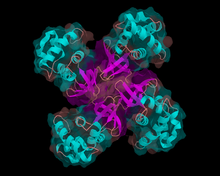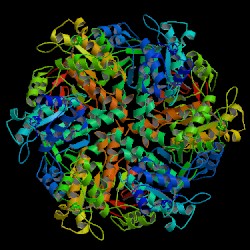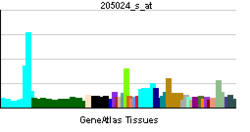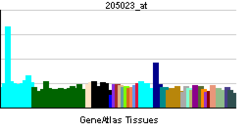1.NBS gene:
============
Nijmegen breakage syndrome
From Wikipedia, the free encyclopedia
Nijmegen breakage syndrome (
NBS), also known as
Berlin breakage syndrome and
Seemanova syndrome, is a rare
autosomal recessive[1] congenital disorder causing chromosomal instability, probably as a result of a defect in the Double
Holliday junction DNA repair mechanism.
NBS1 codes for a protein that has two major functions: (1) to stop
the cell cycle in the S phase, when there are errors in the cell DNA (2)
to interact with FANCD2 that can activate the BRCA1/BRCA2 pathway of
DNA repair. This explains clearly that mutations in the NBS1 gene lead
to higher levels of cancer (see Fanconi anemia, Cockayne syndrome...)
The name derives from the Dutch city
Nijmegen where the condition was first described.
[2]
Most people with NBS have
West Slavic origins. The largest number of them live in
Poland.
Mrs Seemanova MD after whom the name of the syndrome was given, currently works at
Motol Hospital,
Prague,
Czech Republic, as a Professor of medical genetics.===============================================
2. BLM gene
Bloom syndrome protein is a
protein that in humans is encoded by the
BLM gene and is not expressed in
Bloom syndrome.
[1]
The Bloom syndrome gene product is related to the
RecQ subset of DExH box-containing DNA
helicases and has both DNA-stimulated
ATPase and ATP-dependent DNA helicase activities. Mutations causing
Bloom syndrome
delete or alter helicase motifs and may disable the 3' → 5' helicase
activity. The normal protein may act to suppress inappropriate
homologous recombination.
[2]
Interactions
Bloom syndrome protein has been shown to
interact with
CHEK1,
[3] Replication protein A1,
[4][5][6] Werner syndrome ATP-dependent helicase,
[7] RAD51L3,
[8] Ataxia telangiectasia mutated,
[9][10] RAD51,
[11] XRCC2,
[8] Flap structure-specific endonuclease 1,
[12] H2AFX,
[3] TP53BP1,
[3] FANCM,
[13] P53,
[3][14][15][16] TOP3A,
[4][17][18][19] MLH1[9][18][20][21] and
CHAF1A.
[22]
TO UNDERSTAND THAT THE BLM GENE IS A DNA REPAIR GENE, YOU MUST REMEMBER WHAT A 'HELICASE' IS:
Helicase
From Wikipedia, the free encyclopedia

Structure of
E. coli helicase RuvA
Helicases are a class of
enzymes vital to all living
organisms. Their main function is to unpackage an organism's genes. They are
motor proteins that move directionally along a
nucleic acid phosphodiester backbone, separating two
annealed nucleic acid strands (i.e.,
DNA,
RNA, or RNA-DNA hybrid) using energy derived from
ATP hydrolysis.
There are many helicases resulting from the great variety of processes
in which strand separation must be catalyzed. Approximately 1% of
eukaryotic genes code for helicases.
[1] In humans, 95 non-redundant helicases are coded for in the genome, 64 RNA helicases and 31 DNA helicases.
[2] Many cellular processes, such as
DNA replication,
transcription,
translation,
recombination,
DNA repair, and
ribosome biogenesis involve the separation of nucleic acid strands that necessitates the use of helicases.
KEEFE ET AL" Bloom syndrome occurs most frequently in the Ashkenazi Jewish
population with patients almost exclusively homozygous for a frameshift
mutation resulting from a 6 bp deletion/7 bp insertion at nucleotide
2,281 (BLMAsh). This mutation causes premature termination of the
encoded gene product producing a truncated protein of 739 amino acids
while the full length protein contains 1417 amino acids.
The mutated gene in Bloom syndrome, BLM, was localized to chromosome
15q26.1 and encodes a member of the RecQ family of DNA helicases. This
family also contains several other genes that are associated with
disease phenotypes including the Werner Syndrome protein (WRN) and the
defective protein in Rothmund-Thomson syndrome (RecQL4). Both of these
diseases also feature an increased incidence of cancer. BLM, along with
the rest of the members of this family, exhibits 3'-5' helicase
activity and plays a role in DNA repair and recombination. BLM functions
during replication stress and is required for the recruitment of
several other important repair proteins including NBS1, BRCA1, Rad51 and
MLH1. In addition, the BLM helicase is involved in recombinational
repair events as evidenced by its ability to promote branch migrations
of Holliday junctions at stalled replication forks. BLM may also play a
role in apoptosis since it directly interacts with p53 and helps
regulate its transcriptional activity."
=========================================================================
3.ATM gene
Ataxia telangiectasia mutated
From Wikipedia, the free encyclopedia
Ataxia telangiectasia mutated (ATM) is a
serine/
threonine protein kinase that is recruited and activated by
DNA double-strand breaks. It phosphorylates several key proteins that initiate activation of the DNA damage
checkpoint, leading to
cell cycle arrest,
DNA repair or
apoptosis. Several of these targets, including
p53,
CHK2 and
H2AX are
tumor suppressors.
The protein is named for the disorder
Ataxia telangiectasia caused by mutations of ATM.
[1]
GOLDGAR ET AL suggested:
"The risk estimates from this study suggest that women carrying the pathogenic variant,
ATM c.7271T > G, or truncating mutations demonstrate a significantly increased risk of
breast cancer with a penetrance that appears similar to that conferred by germline
mutations in BRCA2."
=============================================================
4. MRE 11 gene
MRE11A
From Wikipedia, the free encyclopedia
Double-strand break repair protein MRE11A is a
protein that in humans is encoded by the
MRE11A gene.
[1]
This gene encodes a nuclear protein involved in homologous
recombination, telomere length maintenance, and DNA double-strand break
repair. By itself, the protein has 3' to 5' exonuclease activity and
endonuclease activity. The protein forms a complex with the RAD50
homolog; this complex is required for nonhomologous joining of DNA ends
and possesses increased single-stranded DNA endonuclease and 3' to 5'
exonuclease activities. In conjunction with a DNA ligase, this protein
promotes the joining of noncomplementary ends in vitro using short
homologies near the ends of the DNA fragments. This gene has a
pseudogene on chromosome 3. Alternative splicing of this gene results in
two transcript variants encoding different isoforms.
[2]
Interactions
MRE11A has been shown to
interact with
Ku70,
[3] Ataxia telangiectasia mutated,
[4][5] MDC1,
[6] Rad50,
[3][5][7][8][9] Nibrin,
[5][9][10][11][12] TERF2[13] and
BRCA1.
[5][7][14][15]
FUKUDA ET AL
"
MRE11,
RAD50, and
XRS2 have been
identified in yeast as components of the HR and NHEJ pathways
(4)
. A physical complex with these proteins has been
identified. In vertebrates, MRE11 and RAD50 form a complex with NBS1,
whose mutation causes NBS
(5
, 6)
. The clinical features of
NBS overlap with those of AT. They are characterized by chromosome
instability, increased hypersensitivity to ionizing radiation,
immunodeficiency, and predisposition to cancer. AT is caused by
mutations in the
ATM gene, which encodes a protein kinase
homologous with phosphatidylinositol-3 kinase
(7)
.
ATM is a key regulator of the cellular response to DSBs. NBS1 is
phosphorylated in an ATM-dependent manner after ionizing radiation,
suggesting a link between ATM and NBS1 in a common signaling pathway
(8)
. MRE11 phosphorylation upon DNA damage is dependent on
NBS1
(9)
. Therefore, it is highly likely that MRE11
participates in the same pathway in response to DNA damage. Consistent
with this functional interaction, hypomorphic mutations in the
MRE11 gene cause ataxia-telangiectasia-like disorder, the
phenotypes of which are indistinguishable from those of AT
(10)
."
ATM mutations play a causal role in AT and have been
demonstrated in lymphoid malignancies
======================================================================
5. RAD51
From Wikipedia, the free encyclopedia
"RAD51 is an eukaryote
gene. The
protein encoded by this gene is a member of the RAD51 protein family which assist in repair of
DNA double strand breaks. RAD51 family members are
homologous to the
bacterial RecA and
yeast Rad51. The protein is highly conserved in most eukaryotes, from yeast to humans.
BRCA genes
This protein can interact with the ssDNA-binding protein
RPA,
BRCA2,
PALB2[3] and
RAD52.
The structural basis for Rad51 filament formation and its functional
mechanism still remain poorly understood. However, recent studies using
fluorescent labeled Rad51
[4]
has indicated that Rad51 fragments elongate via multiple nucleation
events followed by growth, with the total fragment terminating when it
reaches about 2 μm in length. Disassociation of Rad51 from dsDNA,
however, is slow and incomplete, suggesting that there is a separate
mechanism that accomplishes this."
"The RAD51 gene family, genetic instability and cancer.
Source
Medical Research Council, Radiation and Genome Stability Unit, Harwell, Oxfordshire OX11 0RD, UK. j.thacker@har.mrc.ac.uk
Abstract
Inefficient
repair or mis-repair of DNA damage can cause genetic instability, and
defects in some DNA repair genes are associated with rare human
cancer-prone disorders. In the last few years, homologous recombination
has been found to be a key pathway in human cells for the repair of
severe DNA damage such as double-strand breaks. The RAD51 family of
genes, including RAD51 and the five RAD51-like genes (XRCC2, XRCC3,
RAD51L1, RAD51L2, RAD51L3) are known to have crucial non-redundant roles
in this pathway."---------------------------------------------------------------------
THE BRCA ITSELF TO WORK NEED A BUNCH OF VARIOUS COFACTORS CALLED
FANCB-Related Fanconi Anemia,
FANCC-Related Fanconi Anemia,
FANCD2-Related Fanconi Anemia,
FANCE-Related Fanconi Anemia,
FANCF-Related Fanconi Anemia,
FANCG-Related Fanconi Anemia,
FANCI-Related Fanconi Anemia,
FANCL-Related Fanconi Anemia,
FANCM-Related Fanconi Anemia,
PALB2-Related Fanconi Anemia,
RAD51C-Related Fanconi Anemia,
SLX4-Related Fanconi Anemia (ALTER ET AL!)
========================================================================
IN OTHER NEWS...
HPV Vaccine: 2 Doses as Good as 3 Doses in Young Women
Troy Brown. go to article!






